I’m Still Writing
February 14, 2021
My previous post on this blog is dated July 16, 2019, and it was my only post for that year. The theme of this blog is “Spirituality from One Gay Man’s Perspective.” My lack of postings might be a sign that I’ve said all I have to say about spirituality. I don’t think that’s true, and I have been writing.
In 2020 I completed a novel, A Brotherhood of Strangers – not the first novel I’ve written, but the first one where I’ve felt that it was ready to be presented to a broad audience of gay men. It touches on many of the spiritual themes I’ve explored in this blog, but through the voice of a fictional character. In October, I sent it to a publisher but quickly received a notice that said, “The story does not fill our current list needs.”
I then sent it to Toby Johnson, who had once made a blanket offer to help gay authors get published. He encouraged me to self-publish, noting that he had one of his books go out of print because the small publishing firm that had accepted the book went out of business.
It has taken three months to get the book to the point where I felt I had captured enough of the misspellings, typos, repeated words, and other errors so that it was ready for offered to readers.
Last month I read an excerpt at a virtual talent night presented by Easton Mountain. Here’s a video that was made of that event.
Brotherhood Reading from Sunfire Thunderbird on Vimeo.
Easton Mountain’s work as a retreat center has been drastically curtailed by Covid restrictions. To help them at this critical time, I’ve made a special offer of autographed copies of the book. You’ll find it oon their website: eastonmountain.org/bookoffer. If you prefer to read the book on Kindell or Nook, it’s available – of course, without an autograph. Here are the links:
Will I feel led to write more blog posts? I’m not sure. My current spiritual reading is Vagabond Tales, by Pleasant DeSpain – part autobiography, part related stories, part philosophical musings. I follow my usual practice of reading a brief section every day and jouranal on what I’ve read. When I’ve read this book, my intention is to go back into the journals I’ve kept over the years, to see if anything I’ve written is something that should be posted on this blog.
Looking Forward to SUN CLAD
July 16, 2019
Somewhere among my writings, I have an unfinished novel. One of the characters is a man in his twenties who has been making his living by selling his body to other men. The novel is set in the nineteenth century, and he knows too well the dangers he faces every day. He meets a Native American shaman who understands his condition. He accepts the shaman’s invitation to a sweat lodge, and finds himself in a group of men. All of them take off their clothes to enter the lodge; and the young man realizes that he has, in all his adult life, never been naked with another man except to have sex. Now he is naked with a group of men, and their purpose is to pray.
This story holds a lesson for those of us who will gather at Easton Mountain for SUN CLAD.

When I am naked, I am not hiding my masculine power. At the same time, I am not denying the masculine power of another man. I am saying, “I see you as you are; I honor the masculine and the feminine in myself; I honor the masculine and the feminine in you.” This is a lesson the world sorely needs. As men who have sex with other men, we all need to honor and respect the masculine and the feminine within each of us.
At SUN CLAD, I will be offering a series of three workshops, with an overall title of “Naked Mysteries.” These mysteries are those of the masculine and the feminine:
- How can I acknowledge these mysteries, both in myself and in another human being?
- How can I hold the tension of both, the creative power of both?
- How can I affirm the attraction I have for the masculine over the feminine without doing violence to my own inner feminine?
These are questions my workshop will explore through discussion of naked performances on video, through rituals of movement and touch, and through exploring the thoughts and feelings that come up during the discussion and rituals.
If you have followed my blog, you know that I consider myself a spiritual explorer. If you resonate with the questions above, I invite you to join me as a spiritual explorer. One way to do that is to register for SUN CLAD, August 21-25, 2019, at Easton Mountain. Check out this video and the description of the retreat on Easton Mountain’s website
Tantric Practices
July 1, 2018
From the beginning, this blog has been devoted to spiritual exploration. The tools for exploration have been, for the most part, those that I’ve developed and tested as I’ve worked with various teachers from Taoist, Tantric, and healing traditions In this blog, I would like to introduce a teacher whose work I admire. He comes from the Tantric tradition, so much so that he calls himself Jason Tantra.
Here are two videos he has made. One presents a meditation that focuses on love. I regard love as the creative power of the universe, and so I encourage you to try this meditation.
And the next video immediately appealed to me when I heard Jason say, “Take off all your clothes.” How can we know our bodies when we keep them encased in cotton and wool – or worse, polyester and other synthetics?
Jason and his partner, Ingo, will be at Easton Mountain, where I live, August 7-12 for the Tantra Love Festival. I’ll be leading a session at this festival an activating the chakras. Join us and discover the power of a teacher who focuses on manifesting love with an aware body.
More Thoughts on the Author of the Gospel of John
December 23, 2017
My posting of November 21, 2014, gave my theory of who wrote the Gospel of John. I had started to study that Gospel, using a translation by Raymond Brown along with his massive commentary. At the end of October, 2017, I completed my study, which included reading the text and commentary followed by meditating and journaling.
My theory of authorship was that the words of the disciple John were the original source of the material. They were spoken in Aramaic during worship to a community of believers in Asia Minor and translated during worship into Greek for those who did not understand Aramaic. After John’s death, the translators engaged a scribe to write down the words they had remembered – and probably had repeated many times for that early community of believers.
As I continued to study this gospel, I found many passages tha confirmed my theory, with a final confirmation coming in the last two verses of the last chapter.
24 This is the disciple which testifieth of these things, and wrote these things: and we know that his testimony is true.
25 And there are also many other things which Jesus did, the which, if they should be written every one, I suppose that even the world itself could not contain the books that should be written. Amen.
Scholars, including Raymond Brown, have wondered about who are the “we” in verse 24, and who is the “I” in chapter 25. From the standpoint of my theory, the “we” are the translators who met to dictate the words they had been repeating from memory, and the “I” is the long-suffering scribe who – after having the closing words dictated to him that are found at the end of the previous chapter – was called back to add on this chapter.
It is my intention now to go back through my journals and extract those passages which give a clear impression of inspiration that has come to me while studying this gospel. This will be presented in future blog posts.
My Encounters with Butoh
December 16, 2017
Butoh is a form of dance originating in Japan just after World War II. Its creators rejected both the imitation of western dance styles and the classic Japanese theatrical forms of Noh and Kabuki. The raw emotions that early butoh evoked grew out of Japanese war and early post-war experiences. It has been described in the New York Times:
BUTOH IS NOT FOR THE FRAIL. THE AVANT-garde dance form that today is Japan’s most startling cultural export does not aim to charm. Instead, it sets out to assault the senses. The hallmarks of this theater of protest include full body paint (white or dark or gold), near or complete nudity, shaved heads, grotesque costumes, clawed hands, rolled-up eyes and mouths opened in silent screams.
I first saw butoh performed by a Japanese company, Sankai Juku, at SUNY Purchase around 1995. I bought a book of photographs of that company, but beyond that I had no contact with butoh until I met Douglas Allen, a member of Ollom Movement Art, a performance company guided by the choreographer, John Ollom. John, with Douglas assisting. facilitated a weekend in which the participants created their own movement art pieces. I supervised the video-taping of their work.
When I learned that Douglas had studied and practiced butoh, I invited him to perform during the weekend and suggested he use the mud pit that was part of the facility where we were working.
I forgot about the footage I had shot that day. Seven years later I edited it into the form shown above – a form that for me demonstrated the spirit of butoh. I could write a whole book and not cover everything that could be said to define this dance form,. Writing this book would be complicated by the fact that butoh perfomers often avoid giving verbal explanation of their work.
This was the case with Hiroko Tamano, a Japanese performer who has taught in the U.S.
When a completely new student arrived for a workshop in 1989 and found a chaotic simultaneous photo shoot, dress rehearsal for a performance at Berkeley’s Zellerbach Hall, workshop, costume making session, lunch, chat, and newspaper interview, all “choreographed” into one event by Tamano, she ordered the student, in broken English, “Do interview.” The new student was interviewed, without informing the reporter that the student had no knowledge what butoh was. The improvised information was published, “defining” butoh for the area public. Tamano then informed the student that the interview itself was butoh, and that was the lesson.
— From a Wikipedia article on butoh
My feeling is that my video goes beyond being a video of a butoh performance, it also is butoh.
Is Naked Performance Art Right for You?
September 14, 2017
I’ve written several times about the performance duo, Wild Torus: constantly traveling performance artists who have worked with other artists to further audience involvement in performance. In July, I was fortunate to get them to come to a video session in the Ridgewood section Queens. You can get a sense of what happened from the video below.
As you watch it, I suggest you think about three questions:
- What do you get from watching?
- What do you think the performers got from the session?
- Would some type of performance art be valid self expression for you?
I’ll be holding another video session on the afternoon of Saturday, September 23 (2:30 to 5:30 p.m.). This session won’t involve smearing paint on our bodies. It will be an exploration of power, it’s effect on the person who has the power and on the people who give him power.
This session will be guided by a scenario called “The King Needs More Clothes.” In it, a generous king gives his clothes to his subjects; but when he has given everything, his courtiers demand more clothes until the king is overburdened with everyone else’s clothes. Our scenario is a starting point for improvisation. Every performer’s ideas contribute to the final shoot.
Doors will open at 2:10 P.M.
You are welcome at this event if you are at least eighteen years of age, are willing to be photographed with full nudity, and are willing to have this video be available for non-commercial display. You may bring guests if they also meet these qualifications.
Donations to help cover the cost of this event will be accepted, but not required.
Do you want to be part of the September 23 Video Shoot?
If so, please use Facebook to let us know you’re coming, or send a text message with your email address to 518-321-1356. I’ll send you the exact location of the session.
More on Demythologizing Jesus
August 4, 2017
On April 19, 2016, I posted some thoughts I had while studying the Gospel of John. I have now reached the twenty-second chapter, which begins “Early on the first day of the week, while it was still dark, Mary Magdelene came to the tomb. She saw that the stone had been moved away from the tomb; so she went running to Simon Peter and to the other disciple (the one whom Jesus loved) and told them, “they took the Lord from the tomb, and we do not know where they put him.”
I have difficulty with the whole account of the resurrection. My earlier post, “Demythologizing Jesus,” referred to finding an explanation for the changing of water to wine. I find it more difficult to find a plausible, non-miraculous explanation for the last two chapters of the gospel. I’ve put aside studying it for a while. Liberal Protestants often see the resurrection as the disciples having a feeling of the presence of Jesus, and this may be the best we can do.
For many in my own Quaker tradition, Jesus is the one who speaks to them as they sit in silent worship. For other Quakers, the inner voice may be thought of as God, the Holy Spirit, the Earth, or a nameless mystery. The epistles of Saint Paul refer to prophesying, which was speaking out in worship in the same manner as Quakers do today. No one is obligated to think of something said in Meeting to be the Word of God, but if others recognize the truth of what is said, it becomes a truth for the meeting.
When the disciples first felt the presence of Jesus, one of them would speak as he was moved, giving what he felt was Jesus’ message. Others would feel that truth of what he said, and the message would come of all of them. As the accounts of the evangelist were translated into Greek and repeated by early Christians, the reality of Jesus’ appearance was no longer thought of as feeling but rather as sight.
The words of prophesy transformed the disciples from discouraged mourners to valiant apostles. This transformation is the miracle of the resurrection. I will be studying the messages which the disciples received, looking to understand what brought on the faith that transformed the disciples. I’ll report on that in this blog.
Further Active Imagination with the Explorer – Part I
September 28, 2016
From May through December of 2013, I posted a series of articles created using active imagination centered on the figure of an explorer. I have recently been led to return to this type of meditation. The following is another episode that I recorded in 2013. If you have not read the previous postings with this theme, or if you don’t remember them, I suggest checking out my page, “Fantasy/Fables/Fiction,” where you will find links to all the postings with the theme of the explorer in chronological order. You probably find the series more interesting if you read the posts in the order that I created them.
___________________
I found it difficult to sleep that night. So much had happened. I felt very good, very positive; and yet there was so much that was confusing. Not the least of this was how the healer, Matta, knew so much about me. She seemed to know everything, and I wondered about things that she hadn’t said, seeing things that she hadn’t pointed out, she hadn’t dwelled upon.
Did she know my sexual orientation? Did she know my feelings toward other people, people I disliked. Somehow, I felt she did, but that that didn’t matter. I recalled a verse of Scripture where Jesus knew things about a woman that he met and she recognized that. Was Matta in some way another Jesus?
I wondered what kind of religion she had. At least it was one that taught people to be loving; because, of all else, I felt Matta was really loving – and by that I mean accepting, allowing me to be who I was and who I was not, not wanting me to be something different. I felt that I should go and look at Scriptures – Christian Scriptures – read more about Jesus; and yet I had no interest in conventional religion, and somehow something was saying this is not about conventional religion; this is about a spiritual man, the medicine man, who gave me the drugs that eliminated the parasites after a bout of diarrhea and delirium and who knows what. How did he know I had the parasites? My guide had referred to them as evil spirits. There was something I wasn’t quite seeing, and I wasn’t sure what it was.
I wondered if Matta could see evil spirits, if she thought of disease in that way. So I waited. At one point I almost called the Healing Center to break my appointment, but I knew I could not do that. Somehow this was exactly what I needed.
I was spending a lot of time now, as I had promised myself I would. thinking about the direction of my life, where I was going, what I wanted to accomplish – something I knew I could not do in the jungle, in the highlands, anywhere outside of the big city. While I was exploring I couldn’t really keep my attention, my focus, on internal problems; and something said “you must be an explorer of your own mind and accept this without question.” But still wondering what it meant to be an explorer of my own mind. I could do that just as well in my hometown in California or in El Paso or even across the border in Mexico. I wondered if it changed that much in fifty years.
Being Wild with Wild Torus
May 30, 2016
If you’ve been following my blog, you know that I have a Vimeo channel called Erotic Imagination, where I focus on videos that use nudity in staged and filmed performances. As I view them, I try to see what artistic truth is being presented or reinforced by the naked performers.
In 2012, a video by Dimitris Papaioannou, led me to discover that he was performing in Troy, New York. My reaction to his work is recorded on a blog post, “Acting as One”
A week ago Saturday, was only the second time, that I’ve attended an event after seeing videos on Vimeo – this time after seeing “Morte Portus Vitae”
and “Bushwick Coal Mind,” –
two productions of a group called “Wild Torus.”
When I searched for “Wild Torus” on the internet, I found comments like these:
“All I could see were a number of sweaty, naked bodies covered in stickiness and powder.”
“I couldn’t distinguish between men, women, and blow-up dolls.”
“Let me tell you, “wild” in @wildtorus is a serious understatement. These guys are bat-sh*t crazy,.”
“I decided if I stayed one more moment I risked tumbling head-first into a DMT-fueled trip back to whatever the hell regrettable things I was doing at festivals as a teenager. And I wasn’t about to strip, which made things slightly awkward– clothing wasn’t optional here, it was seriously frowned upon.”
On the evening I attended, all of the spectators except two kept all their clothes on. One female performer was naked at the end, but no man’s cock was ever visible.
The event consisted of a number of acts crammed into a small space with only a few chairs – most of the audience standing or sitting on the floor. Wild Torus was scheduled for the last act of the evening. This evening, it wasn’t their act that took the prize for being “bat-sh*t crazy.” That came earlier, when bare-breasted Phoebe Novak, carrying a violin and two violas, stepped on a large pice of black plastic that had been put down to serve as her stage. From a box, she produced a number of pieces of broken mirror. She then got spectators to tape these broken shards to her bare skin.
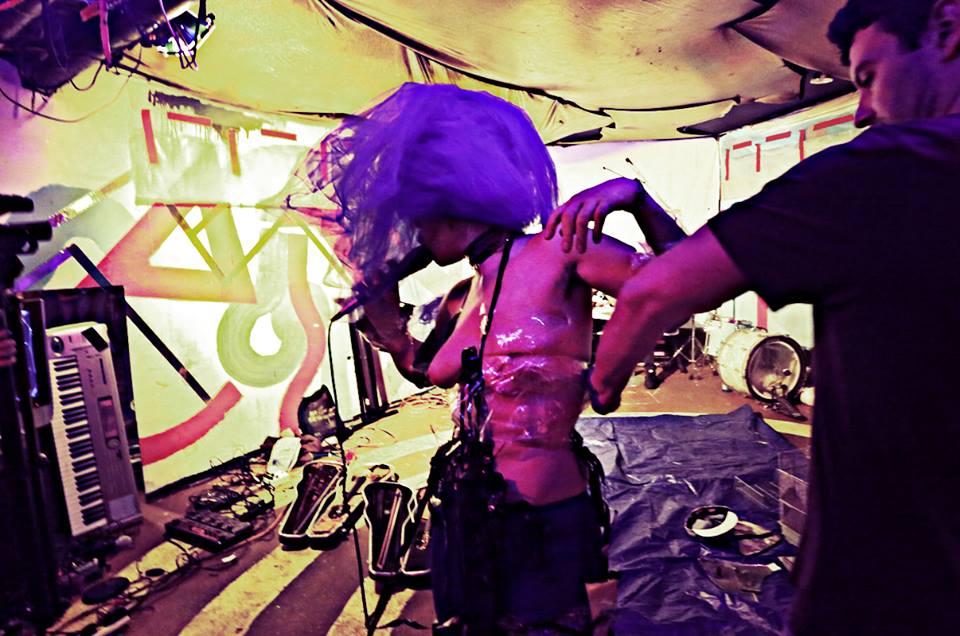
As she bowed her violin, and later the violas in turn, one of the pieces of broken mirror poked into her bare breast. I found myself wondering if the pain in the music was a direct result of this painful act of bowing or if she was using this pain to stimulate emotional pain of previous experiences. Suddenly, she called an end to her performance, gather her stringed instruments from audience members who had been plucking them, and moved into the adjoining back room of Torus Porta. There were a few drops of blood on the floor.
Most of the acts focused more on sonic phenomenon rather than visual, until the final piece – the work of Wild Torus itself. This started with the performance artist Rudi Salpietra singing with Marc Mosteirin accompanying him on a Korg keyboard. When I asked Marc afterwards if they had rehearsed, he said that it was entirely improvised, but that he had a close relationship with Rudi that helped make the song work. After the song, translucent plastic was rolled down on two sides of the performance space. This made it difficult to see the performers covering each other with poster paint.
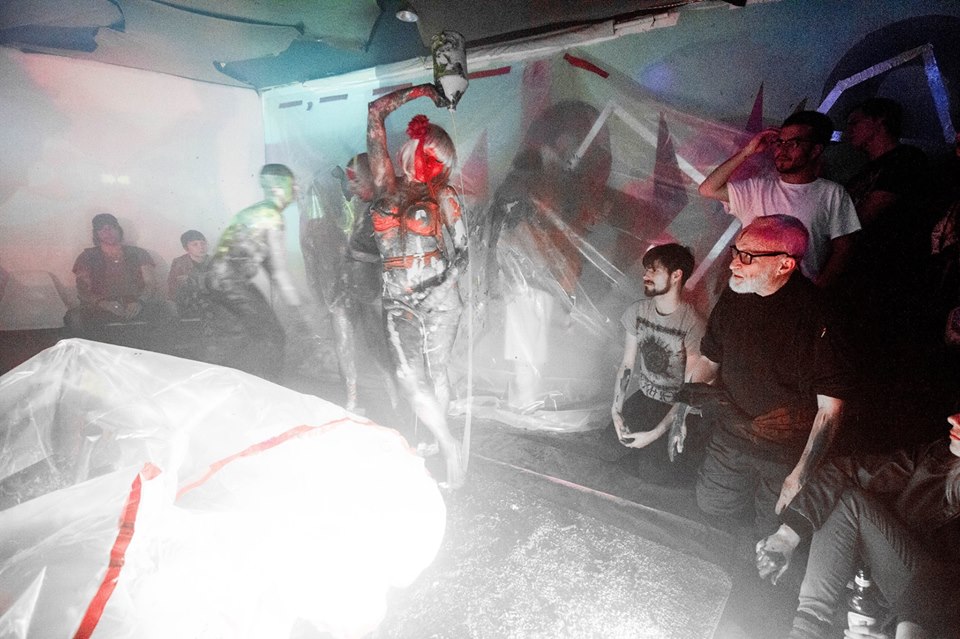
I moved out from behind the plastic to see better and later stripped to my briefs to let my body be covered with paint.
What is there to say about all of this? It’s hard to know. What I can say is that I see in Wild Torus performers taking risks, inviting each other to take risks and inviting the audience to take risks. Do these risks help us know who we are? Do they help us be more truly what we are meant to be? Only by taking the risks can I find out.
In the end, we were left to clean ourselves up as best we could. If I had designed the ritual I would have added a section where the performers and those audience members who were covered with paint clean each other up.
The performers of Wild Torus are now in Europe. When they return, I hope to further my exploration of their brand of wildness and to report on that exploration in this blog.
Cosmology in Art
May 7, 2016
Last summer, I had three three small watercolors on display at Saratoga Arts. Each measures seven by seven inches and is in a ten-by-ten-inch frame. All of the paintings, drawings and photos in the exhibition were in ten-by-ten frames in keeping with the theme of the exhibition “10 X 10 = 100” celebrating the one hundredth anniversary of the chartering of Saratoga Springs.
The three paintings are part of a series I call “Windows of the Soul.” They are paintings of images that have come to me in meditation, though the images have evolved during the course of making preliminary sketches and the final painting. I work with a cosmology that regards the universe as agapic – coming from love – as noetic – supporting thought – as morphogenetic – and as an electromagnetic-gravitational space-time continuum. Out of love comes thought, out of thought comes life, and out of life comes the world of matter, energy, space and time.
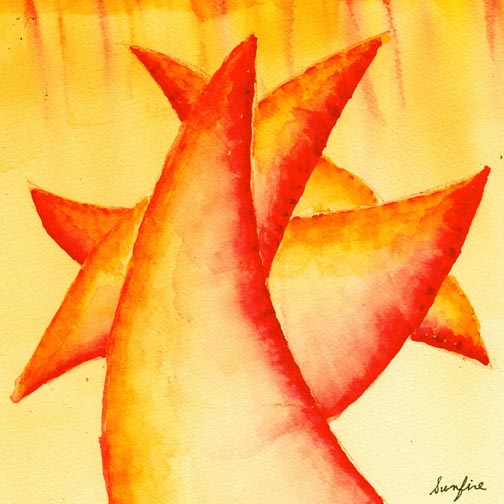
Windows of the Soul, One
The first painting relates to the noetic world, with shapes that come from ten arcs.
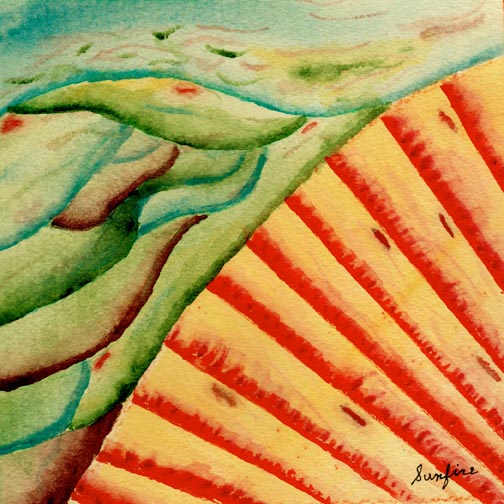
Windows of the Soul, Two
In the second painting the noetic world, represented by streams of light coming from the lower right, gives rise to the morphogenetic – the world of life in the left and upper part of the painting.
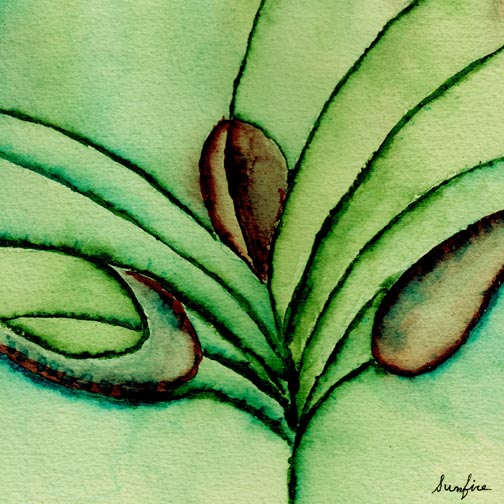
Windows of the Soul, Three
The third paining represents something alive, something coming out of the morphogenetic world manifested as matter and energy in space and time.
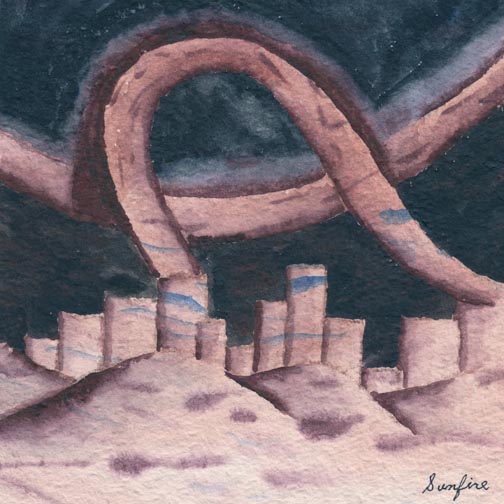
Windows of the Soul, Four
A fourth painting, not in the exhibition, shows a town or city in a desert, with something in the sky that represents the agapic-noetic-morphogenetic expressing itself through the human creation of the city.
Since the exhibit at Saratoga Arts, I have completed three more paintings in the series.
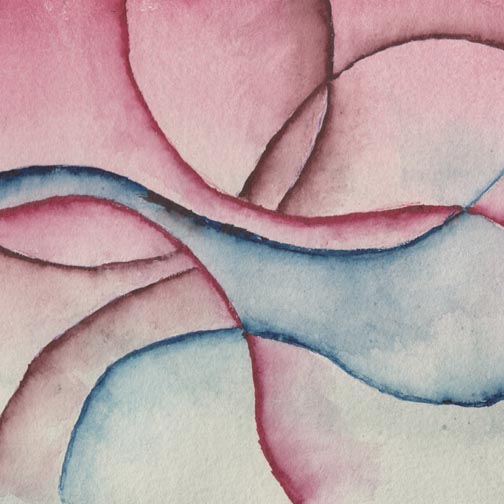
Windows of the Soul, Five
“Windows of theSoul, Five” expresses a morphogenetic field in abstract forms that have something of the quality of human flesh.
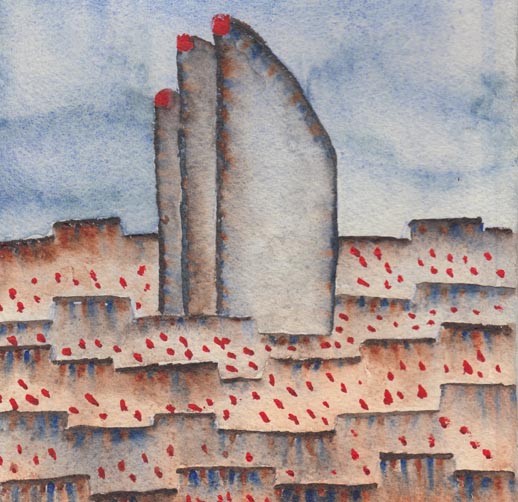
Windows of the Soul, Six
“Windows of the Soul, Six” continues the theme of “Windows of the Soul, Four” but references a more modern city.
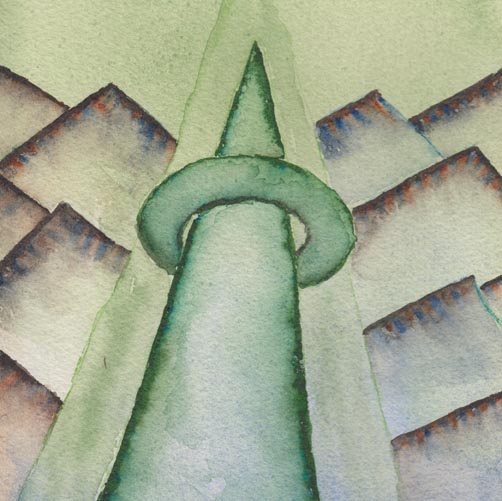
Windows of the Soul, Seven
“Windows of the Soul, Seven” has of a sci-fi element. Thus Windows, Four”, “Six,” and “Seven” together represent past, present and future.
“Windows of the Soul, Eight” and “Nine” are still works in progress. When they are completed, they will appear on this blog.